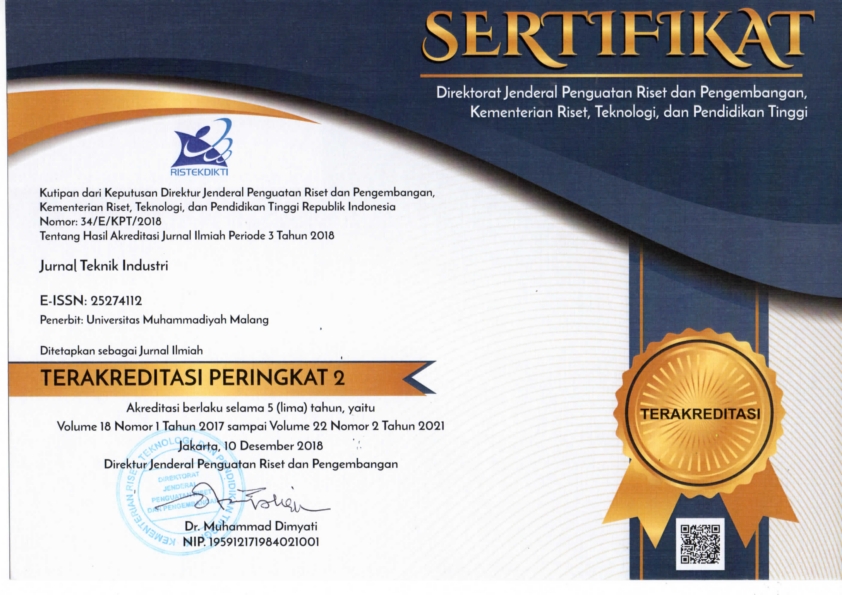Optimasi Kondisi Depolimerisasi Pulp Biji Kakao
DOI:
https://doi.org/10.22219/JTIUMM.Vol9.No1.45-54Keywords:
depolymerization, polygalacturonase, cocoa pulpAbstract
Pulp breaking on cocoa processing could be conducted with depolymerization of cocoa pulp by enzyme polygalacturonase (PG) endogenous. This research was aimed to determination the optimum condition of depolymerization of cocoa pulp by enzyme polygalacturonase endogenous during incubation. This research was carried out by incubating cocoa pulp for 6 days on various of optimum condition of PG endogenous treatments, that is: temperature were 32.5o C, 37.5o C, 42.5o C, 47.5o C, 52.5o C and initial pH of pulp were 4.1; 4.6; 5.1, respectively. Optimum condition of depolymerization of cocoa pulp was determination by effectiveness test. Effectiveness test result, based on the highest effectiveness index, showed that the optimum condition of depolymerization of cocoa pulp was 47.5o C incubation temperature and 4,6 initial pH of pulp. Those treatment produced 18.29% of pulp liquid wieght total during 5 days incubation with average per day for pectin content, galacturonic acid content, acid total content, and the change of pH were 1.12%, 8.36%, 0.209 meq NaOH/g and 0,19 in cocoa pulp extract was incubated for 6 days, respectively.
Downloads
References
Alamsyah, T.S., 1991. Peranan fermentasi dalam pengolahan biji kakao kering. Suatu Tinjauan.
Berita Perkebunan, 1(2): 97–103.
Carr, J.G. 1982. Cocoa. In A.H. Rose (Ed.). Fermented Foods. New York: Academic Press, Inc.
De Garmo, E.G., W.G. Sullivan dan J.R. Cerook., 1984. Engineering Economy. 7th. Edition. New York: Macmilland Publ. Co.
Fox, P.F., 1991. Food Enzimology. Vol. 1. London. Elsevier Applied Science Publishers Ltd., p. 636.
Ganda Putra, G.P., Harijono, T. Susanto dan S. Kumalaningsih, 2006. Isolasi, karakterisasi dan optimasi enzim pektolitik endojinus pada pulp biji kakao. Prosiding Seminar Nasional Basic Science III di FMIPA-Universitas Brawijaya, Malang tanggal 25 Pebruari 2006.
Gardjito, M. dan Wardana, A.S., 2003. Hortikultura, Teknik Analisis Pasca Panen. Yogyakarta: Transmedia Mitra Printika.
Huang, L.K.dan R.R., Mahoney, 1999. Purification and characterization of an endo-polygalacturonase from Verticillium albo-atrum. J. App. Microb., 86 (1) : 145-156.
James, C.S., 1995. Analytical Chemistry of Foods. , London: Blackie Academic & Professional.
Lopez, A.S., 1986. Chemical change occurring during the processing of cacao. Proceeding of The Cacao Biotechnology Symposium. Dept. Of Food Science College of Agricultutre, The Pennsylvania State University, Pennsylvania, USA.
Munoz, R. dan A.R. Barcelo, 1996. Enzymes. In L.M.L. Nollet (Ed.). Handbook of Food Analysis. Vol. 1. New York: Marcel Dekker, Inc.
Schwan, R.F. 1998. Cocoa fermentations conducted with a defined microbial cocktail inoculum. Appl. Environ Microbiol., 64(4): 1477–83.
Stephen, A.M. 1995. Food Polysaccharides and Their Applications. New York: Marcel Dekker, Inc., p. 654.
Sudarmadji, S.B. Haryono dan Suhardi, 1997. Prosedur analisis untuk bahan makanan dan pertanian. Yogyakarta: Penerbit Liberty.
Sulistyowati, 1988. Keasaman biji kakao dan masalahnya. Pelita Perkebunan, 3(4): 151–8. SNI 01-2323-1995. Standar Nasional Indonesia Biji Kakao. Dewan Standardisasi Nasional-DSN, Jakarta.
Whitaker, J.R., 1996. Enzymes. In O. R. Fennema (Ed.). Food Chemistry. 3rd Edition. New York: Maecel Dekker, Inc., p. 1067.
Winarno, F.G., 1992. Kimia Pangan dan Gizi. Jakarta: PT Gramedia Pustaka Utama.











